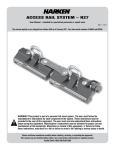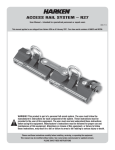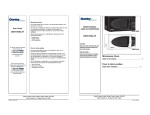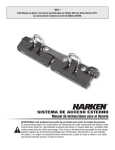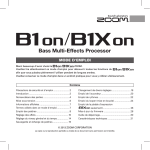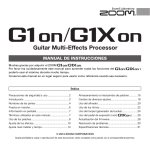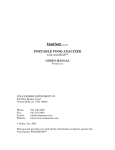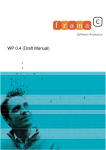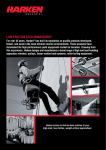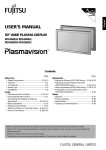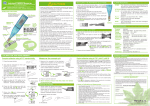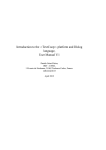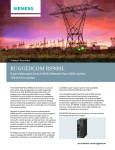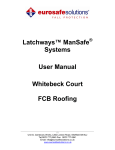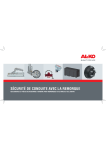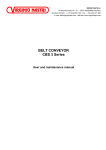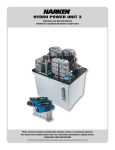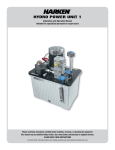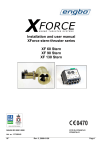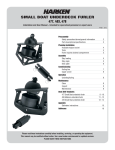Download ACCESS RAIL SYSTEM – R27
Transcript
ACCESS RAIL SYSTEM – R27 User Manual – Intended for specialized personnel or expert users 4684.1 This manual applies to cars shipped from Harken USA as of February 2011. Cars have serial numbers of A0633 and B0768. WARNING! This product is part of a personal fall arrest system. The user must follow the manufacturer’s instructions for each component of the system. These instructions must be provided to the user of this equipment. The user must read and understand these instructions before using this equipment. Manufacturer’s instructions must be followed for proper use and maintenance of this equipment. Alterations or misuse of this equipment, or failure to follow these instructions, may result in a fall or failure to arrest a fall leading to serious injury or death. Please read these instructions carefully before installing, servicing, or operating the equipment. This manual may be modified without notice. See: www.harken.com/manuals for updated versions. PLEASE SAVE THESE INSTRUCTIONS Parts Description Pivot Pin Retaining Screw Forged Stainless Steel Shackle Car Coupler Screw/Pivot Pin Retaining Screw Car Coupler Working Car Wheeled toggle attachment achieves angles up to 90° Forged Stainless Steel Shackle HC10567.CLEAR Pivot Pin Retaining Screw Lever-Actuated Pinstop HC9606 Pinstop Track Lever-actuated pinstop locked 1643.3m 1643.3.6m 1643.6m Fall Arrest Car High-Load Pinstop Track 1644.3m 1644.3.6m 1644.6m HC9606.CLEAR Pinstop Track 1643.3m.CLEAR; 1643.3.6m.CLEAR 1643.6m.CLEAR; 1644.3m.CLEAR 1644.3.6m.CLEAR; 1644.6m.CLEAR Lever-actuated pinstop unlocked Splice Link 1619 Endstop (Pair) HC9561.CLEAR Endstop (Pair) HC9561 Add .CLEAR to part number for clear-coat finish Car Assembly Length mm in 273 103/4 Part No. HC9606* Description R27 Access Rail car assembly/coupler Includes: 1 x HC9565; 1 x HC9608; 1 x H-50547 HC10567** R27 Access Rail car assembly/coupler/wheel toggle 273 103/4 Includes: 1 x HC10614.CLEAR; 1 X HC10615.CLEAR; 1 X H-50547 *Available in clear-coat finish. To order add .CLEAR to the part number **Available in black Hardkote finish mm 70 in 23/4 Maximum working load Fits kg lb track 135 297.68 1643.3m* 70 2/ 135 Width 3 4 297.68 1643.3m* Comments CE-approved system See drawing H-49971 on page 11 Track and Accessories Part No. 1643.3m* 1643.3.6m* 1643.6m* 1644.3m* 1644.3.6m* 1644.6m* 1619 HC9561* Length Mounting hole spacing Description m ft/in mm in 100 315/16 R27 high-load pinstop track 3 9'101/16" 100 315/16 R27 high-load pinstop track 3.6 11'93/4" 100 315/16 R27 high-load pinstop track 6 19'81/4" 50 131/32 R27 high-load pinstop track (special order, allow 3 - 4 weeks for delivery) 3 9'101/16" 50 131/32 R27 high-load pinstop track (special order, allow 3 - 4 weeks for delivery) 3.6 11'93/4" 50 131/32 R27 high-load pinstop track (special order, allow 5 - 7 weeks for delivery) 6 19'81/4" Splice link Purchase one splice link for each track section. Endstop (pair) Use one at each end of system track. *Available in clear-coat finish. To order add .CLEAR to the part number **Socket Head Cap Screw Fasteners mm in 5/16 FH 8 FH 5/16 FH 8 FH 5/16 FH 8 FH 6 SHCS** 1/4 SHCS** 6 SHCS** 1/4 SHCS** 6 SHCS** 1/4 SHCS** Optional Parts Length Width Maximum working load Part Fits No. Description mm in mm in kg lb track 3/16 3 70 2 /4 135 297.68 1643.3m* HC9565* R27 Access Rail car/pinstop 132 5 70 23/4 135 297.68 1643.3m* HC9608* R27 Access Rail car 273 103/4 70 23/4 135 297.68 1643.3m* HC10614** R27 Access Rail car/pinstop/wheel toggle 132 53/16 70 23/4 135 297.68 1643.3m* HC10615** R27 Access Rail car/wheel toggle 132 53/16 H-50547 Car coupler Use to couple two cars. Includes two stainless steel fasteners and Mylar washers. *Available in clear-coat finish. To order add .CLEAR to the part number **Available in black Hardkote finish Comments Use to hang tool bag, etc. Car Coupler H-505471 Access Rail Car/Pinstop HC9565 2 Access Rail Car HC9608 Access Rail System – R27 Access Rail Car/ Pinstop/Wheel Toggle HC10614.CLEAR Access Rail Car/ Wheel Toggle HC10615.CLEAR 1) Applications A Purpose The track and car system is designed for use as an adjustable anchorage point for external access to facilitate external maintenance on vessels. 1 2 3 1. Full-Body Safety Harness Use a full-body safety harness attached to access car with pinstop. Full-body safety harness must meet /ANSI support standards. 2. working harness CAR Use a working harness or chair attached to access car. Working harness or chair must meet /ANSI support standards. The system has two anchorage points. One anchorage point for a personal suspension system and the second for the fall-arrest system. 3. tool service car Add an optional car and coupler to work as your tool service carrier. B Limitations Capacity: This system is designed for use by one person with a combined weight (clothing, tools etc) of no more than 135 kg (297.68 lb). No more than one person may be connected to a two-car assembly at one time. Free Fall: Personal fall arrest systems used with this equipment must be rigged to limit the free fall to no more than 1.8 m (6 ft). Personal Suspension System must be rigged so that no vertical free fall is possible. Fall Clearance: There must be sufficient clearance below the user to arrest a fall before the user strikes the ground or other obstruction. Height of user plus extended safety lanyard length must not be more than the height from rail to ground minus 2 m (6.5 ft). Swing Falls: Minimise swing falls by working as close to the anchorage point as possible. Load Angle Limitations: Harken cars beginning with A0633 and B0768 with 8 mm shackles have the ability to handle loading at an angle up to 15° beyond vertical. Loads beyond 15° from vertical will overload car. See drawing at right. Exception: HC10567 wheel toggle cars can handle greater angles. See next page. Training: This equipment must be installed and used by persons trained in its correct application and use. C Standards This system has been tested to EN795:2012 standard and is appropriate for single person use with an energy absorber to EN355. Check CE label on side of car for serial numbers. 15° Harken HC9606 cars beginning with A0633 and B0768 with 8 mm shackles have the ability to handle loading at an angle up to 15° beyond vertical. Loads beyond 15 degrees from vertical will overload car. 2) System Requirements Harken equipment is designed for use with Harken approved components. Substitutions or replacements made with non-approved components may jeopardize compatibility of equipment and may affect the safety and reliability of the system. Connectors (hooks, carabiners and D-rings) must be capable of supporting at least 22kN (5000 lbs), in accordance with EN362. Personal Fall Arrest Systems used with this equipment must meet EN813 requirements and include a shockabsorbing lanyard (to EN355 standard) and a full body harness (to EN361, EN358, EN813 standard). WARNING! Consult Harken when using this equipment in combination with components or subsystems other than those described in this manual. Altering or intentionally misusing this equipment may cause the system to fail which can cause a fall which could result in severe injury or death. Access Rail System – R27 3 3) Installation PLAN SYSTEM Consider all factors that will affect safety during use of this equipment. INCORRECT CORRECT Track must be laid out and positioned as determined by a naval architect or other suitably qualified person. User must ensure that distance required to arrest fall is less than obstruction below. Height of user plus extended safety lanyard length must not be more than the height from rail to ground minus 2 m (6.5 ft). Track should run horizontal to water plane, but can be mounted at various angles on this horizontal structure. Ceiling Mount Wall Mount Installer shall ensure suitability of base materials into which track is fixed and that it is capable of sustaining test force as detailed in standard EN795, Type D. The following publications give detailed information to ensure safe and legally compliant installation. EN795:2012 – Protection against falls from a height – Anchor devices – Requirements and Testing. BS7883:2005 – Code of practice for the design, selection, installation, use and maintenance of anchor devices conforming to BS EN 795. MGN422 (M) – Use of Equipment to undertake work over the side on yachts and other vessels. (see Appendix A). Harken External Access System – Installation and Proof Testing Advice. (see Appendix B). Avoid attaching system components where suspension and/or fall arrest rope may come in contact with, or abrade against, unprotected sharp edges. Wheel Toggle Car HC1057 Car Assembly/Wheel Toggle This car is designed to run along a surface, mounted so that the toggle overhangs the edge. Ensure that the whole wheel width is in good contact with the surface to which the track is attached. Ensure that the surface is strong enough to sustain the expected working load and wear. TRACK INSTALLATION Mounted in recess: cars with wheel toggle for loading over an edge This Access Rail system should be installed only by a competent person or competent organization. Mounted on angle: cars with wheel toggle face outward All track listed in this manual is designed to use stainless steel fasteners. Attachment to vessel must be in accordance with MGN 422(M). Harken does not recommend installing with aluminum fasteners. Use of non stainless steel fasteners is at the liability of the installer and must be designed to meet the requirements of MGN 422(M) in Appendix A and Proof Testing in Appendix B. Always use threadlocking solution or locknuts. Precise track alignment at joints is critical for smooth-running cars. Use Splice Links, Part 1619, and round rods and spring clamps to align track during installation. Use transfer punch to mark hole centers. Keep track in alignment, until secured, with spring or "C" clamps when marking, drilling holes and inserting fasteners. To prevent cars from rolling off track, fasten endstops to track ends using M8 (5/16") stainless steel fasteners. All track and endstop fasteners must be coated with an anti-corrosion compound such as Tef-Gel. Use transfer punch to mark hole centers. Hold track in alignment, until secured, with spring or "C" clamps when marking and drilling holes. Installer must ensure that instructions and limitations of use are clearly displayed close to system. This should include a statement that it is designed exclusively for use of personal protective equipment. 4 Access Rail System – R27 4) Use After a Fall: Any equipment which has been subjected to the forces of arresting a fall must be removed from service immediately and destroyed by user or an authorised person. Rescue: when using this equipment, the employer must have a rescue plan and the means at hand to implement it and communicate that plan to users, authorised persons, and rescuers. Personal Fall Arrest Equipment When using a hook with positive locking mechanism to connect to car shackle, ensure roll-out cannot occur. Roll-out occurs when interference between hook and mating connector causes hook gate to unintentionally open and release. Self-locking snap hooks and carabiners should be used to reduce possibility of roll-out. Do not use hooks or connectors that will not completely close over attachment object. Follow manufacturer’s manual for correct use of energy-absorbing lanyard. Follow manufacturer’s instruction manual for correct use of bosun’s chair and certified safety harness. Do not attach a connector such that it will impact on the side of the car when in use. WARNING! This product is part of a personal fall arrest system. The user must follow the manufacturer’s instructions for each component of the system. These instructions must be provided to the user of this equipment. The user must read and understand these instructions before using this equipment. Manufacturer’s instructions must be followed for proper use and maintenance of this equipment. Alterations or misuse of this equipment, or failure to follow these instructions, may result in a fall or failure to arrest a fall leading to serious injury or death. 5) Training It is the responsibility of the user and the purchaser of this equipment to assure that they are familiar with these instructions, trained in the correct care and use of, and are aware of the operating characteristics, application limits, and the consequences of improper use of this equipment. 6) Inspection INSPECT BEFORE EACH USE A C B C B B B D E A formal inspection of the track and its connection to the structure must be performed at least annually by a competent person other than the user. The inspection should be recorded in an inspection and maintenance log. BEFORE EACH USE A) Inspect pinstop for spring degradation, cracks or wear that may affect locking strength and operation. Check drive pin holding plastic latch to post to make sure it is secure. WARNING! If pinstop locking mechanism fails cars may become loose on track resulting in an uncontrolled slide along track resulting severe injury and death. Access Rail System – R27 Drive Pin A 5 6) Inspection B) Inspect Pivot Pin Retaining Screws in cars and coupler. Make sure Coupler/Pivot Pin Retaining Screws have not loosened and are tightened securely in coupler. If loose, remove screw, apply Red Loctite® and tighten. CORRECT INCORRECT WARNING! If screws loosen, shackle pivot pin can move, allowing shackle to suddenly release from car resulting in a fall, severe injury and death. C) Inspect shackles for signs of corrosion, cracks, or elongation. If damaged, do not use. Damaged shackles can indicate that car was overloaded. Return complete car assembly to one of the service centers/recertification centers listed on back of manual for advice. B B CORRECT INCORRECT D) Check all track screws to make sure they have not loosened and are flush with top of track. Screws must be flush with top of track to allow cars to roll smoothly. Loose screws can also compromise system safety. WARNING! If all screws are not fastened securely, track can separate from mounting surface resulting in a fall, severe injury and death. B B INCORRECT E) Inspect endstop screws to make sure they have not loosened and are flush with top of endstop. WARNING! If endstop screws loosen cars can roll off end of track resulting in a fall, severe injury and death. If car has been removed from track, make sure car contains all 60 balls. Do not load car assembly if balls are missing. WARNING! If car has been removed from track some balls may be lost. Do not use cars if balls are missing. Cars with missing balls may come off track resulting in a fall, severe injury and death. See page 8. B CORRECT E 6 Access Rail System – R27 INCORRECT E 6) Formal Inspection A formal inspection of track for cracks, deformation or wear and its connection to structure must be performed annually by a trained person. Record inspection results in a log. See page 10. Remove and inspect cars for damage, corrosion, strength and operation. Remove shackle from car to inspect hidden portion. A) Remove Car Coupler/Pivot Pin Retaining Screw. If necessary heat screw with a propane torch to break red Loctite® bond. B) Tip car so Pivot Pin slides out. C) Remove shackle and inspect. If it shows any sign of corrosion cracking or wear, return complete car assembly to a service/recertification center listed on the back of this manual for advice. D) Reassemble parts using red Loctite®. A B C D E Access Rail System – R27 7 6) Inspection Inspect cars' Torlon ball bearings. Make sure there are no ‘flats’ as they will impede car movement. Damaged balls may indicate high load or high wear. Return complete car assembly to one of the service/recertification center listed on the back of this manual for advice. Make sure that all races have the correct number of balls (see chart below/right). Do not use system until missing balls have been replaced. WARNING! Do not use cars if balls are missing. Cars with missing balls may come off track resulting in a fall, severe injury and death. Car HC9606 HC9565/HC9608 Balls/Car 60 60 Balls Torlon Torlon Order 1526 1526 Balls/Set 25 25 To replace lost balls, position car on edge with retaining clip in place. Do not remove retaining clip. Gently push one ball at a time into car from center of clip. Allow balls to roll into return race and insert remaining balls. Do not overfill each car must have 60 balls! Inspect pinstop for spring degradation, cracks or wear that may affect locking strength and operation. Inspect track for cracks, deformation or wear. Inspect attaching fasteners for loosening, damage or corrosion that may affect strength. See Inspection “BEFORE EACH USE”, pages 5, 6, 7. Service If inspection reveals an unsafe or defective condition, remove item from service and destroy it. If in doubt please contact manufacturer for further advice. 8 Access Rail System – R27 Ball Ø /16"(8mm) 5 /16"(8mm) 5 7) Maintenance Flush cars frequently by squirting a detergent/water solution into center openings. Roll car back and forth to distribute evenly, then flush bearings with fresh water. Cleaning and Flushing Point After car dries, apply one or two drops of McLube® OneDrop™. Roll car back and forth to distribute. Do not use spray lubricants because ball bearings may skid not roll. It is important to clean car as excessive build-up of grease, dirt and salt will restrict car movement. Cleaning and Flushing Point Cleaning and Flushing Point After car dries, apply one or two drops of McLube® OneDrop™. Roll car back and forth to distribute. Access Rail System – R27 9 8) Labeling The following is an example and explanation of the product labelling: HC9608 A0000 1 2 www.harkenindustrial.com Access Rail System R27 EN 795.2012 3 4 5 0321 6 4686 7 1. Product part number; 2. Serial number; 3. Manufacturer’s name; 4. Product name; 5. Number of document to which the equipment conforms; 6. CE symbol; 7. Pictogram indicating the necessity for users to read the instructions for use and label part number. 9) Records A record must be kept for each component, subsystem and system, with the following details (see example record log below). It is the responsibility of the user organisation to provide the record and to enter onto the record the details required. EQUIPMENT RECORD Product: Model/Type Manufacturer Description Serial Number Address Tel/Fax/Email/Website HARKEN N15W24983 Bluemound Rd Pewaukee, WI 53072-4974USA (262) 691-3320 / (262) 701-5780 [email protected] / www.harken.com Year of Manufacture Purchase Date Date First Put Into Use Other important information (i.e. document number): EXAMINATION/REPAIR HISTORY Date 10 Reason for Entry (Periodic exam or repair) Defect notes, repairs carried out and other important information Access Rail System – R27 Name and signature of compentent person Date of next periodic examination Drawing H-49971 Access Rail System – R27 11 Appendix A MARINE GUIDANCE NOTE MARINE GUIDANCE NOTE MGN 422 (M) MGN 422 (M) Use of Equipment to Undertake Work Over the Side Use of Equipment toVessels Undertake Work Over the Side on Yachts and Other on Yachts and Other Vessels Notice to all Shipowners, Masters and Crew Notice to all Shipowners, Masters and Crew This notice should be read with the Code of Safe Working Practices for Merchant Chapters 4 and This noticeSeamen should be read with the 15 Code of Safe Working Practices for Merchant Seamen Chapters 4 and 15 PLEASE NOTE:Where this document provides guidance on the law it should not be regarded as definitive. PLEASE NOTE:The way the law applies to anyguidance particular canitvary according circumstances - for Where this document provides oncase the law should not be to regarded as definitive. example, from vessel to vessel and you should consider seeking independent legal advice if The way the law applies to any particular case can vary according to circumstances - for you are unsure of your own legal position. example, from vessel to vessel and you should consider seeking independent legal advice if you are unsure of your own legal position. Summary This MGN provides guidance on the Summary use of “rail and trolley” and similar systems for undertaking “overside”guidance work on yachts anduse other main and pointssimilar are: systems for This MGN provides on the of vessels. “rail andThe trolley” • to ensure that new systems comply with BS standards; undertaking “overside” work on yachts and other vessels. The main points are: •• to systems havewith been to an equivalent standard; to ensure ensure that that existing new systems comply BSchecked standards; •• to have been trained in their use; to an equivalent standard; to ensure ensure operators that existing systems have been checked •• to ensure maintenance is carried out to the manufactures advice to ensure operators have been trained in their use; Annex 1 give details of the relevant legislation that applies and Annex • to ensure maintenance is carried out to the manufactures advice2 give details of testing and operation. Annex 1 give details of the relevant legislation that applies and Annex 2 give details of testing and operation. 1. Introduction 1. Introduction 1.1 The use of single point safety “rail and trolley” systems is becoming more prevalent on vessels, mega-yachts. These crewmembers to work outside conventional 1.1 The use especially of single point safety “rail and allow trolley” systems is becoming more prevalent on guardrails for cleaning and maintenance purposes on yachts or other vessels. In recent vessels, especially mega-yachts. These allow crewmembers to work outside conventional years thereforhave been and a number of accidents usingonsubstandard equipment of this type. guardrails cleaning maintenance purposes yachts or other vessels. In recent Also there has been evidence that the manufacturers’ instructions on their use are not years there have been a number of accidents using substandard equipment of this type. being followed. The purpose of this notice is to give guidance on their use. Also there has been evidence that the manufacturers’ instructions on their use are not followed.ofThe of this notice is to give guidance their use.if necessary into 1.2 being Most consist twopurpose travellers linked in tandem that can beon separated independent are fitted a metal track which allows the travellers to glide 1.2 Most consist units. of twoThese travellers linkedto in tandem thatrail can be separated if necessary into along it. There is the option of having more than one traveller on the rail. However, many of independent units. These are fitted to a metal track rail which allows the travellers to glide these systems have been designed, and installed, for the sole purpose of sail handling and along it. There is the option of having more than one traveller on the rail. However, many of not forsystems supporting workers working over side of for thethe vessel. these have been designed, andthe installed, sole purpose of sail handling and not for supporting workers working the side vessel. for the purpose and it is not 1.3 Equipment which is used for lifting over persons mustofbethe designed acceptable to use a work station harness or a bosun’s chair attached to a railand andit trolley 1.3 Equipment which is used for lifting persons must be designed for the purpose is not system designed for sail handling to enable window cleaning or other overside acceptable to use a work station harness or a bosun’s chair attached to a rail and trolley maintenance to be undertaken. system designed for sail handling to enable window cleaning or other overside 12 maintenance to be undertaken. Access Rail System – R27 -1- Appendix A 2. Installation 2.1 Any newly installed rail and trolley system used should be tested, certified and approved to a recognised European Union standard for fall protection equipment (EN795; 2012) and should display the CE mark. More information on these requirements is contained in Annex 2. 2.2 Where it is proposed to use a rail and trolley system, or other system, (ie. a system already fitted) that has not been specifically designed for supporting crew members over the side, its use for overside work is not permitted without written confirmation having been received from the manufacturer, preferably by means of a certificate, that use for such purposes is permissible including any conditions attached to its use for that purpose. 3. Operation 3.1 Before use the employer should ensure that: 3.1.1 the manufacturers’ instructions are read and understood by the persons who will be using the equipment; 3.1.2 a risk assessment is carried out and an appropriate rescue plan developed to recover persons who fall into the water; and 3.1.3 crew members are competent to use the equipment and are aware of any conditions relating to its use and their safety. 3.2 Rail and trolley systems for working overside should not be used whilst the vessel is underway. 3.3 These systems are designed to be used with the appropriate PPE (harnesses, lanyards, fall arresters and other devices). 3.4 On systems referred to in paragraph 2.1 there is a single attachment on each traveller designed to accommodate a single line such as a harness. One of the travellers is fitted with a locking device. The device which locks the traveller in position along the track rail must ONLY be disengaged from the track rail while the user is changing position. Once the user is in position, the locking MUST be re-engaged to hold the car in position and limit the user’s movement along the track rail. 3.5 The user must NEVER rely on only one attachment point for personal protective equipment. The working harness should be attached to one traveller and a fall arrestor, or other safety device, to the other. A third traveller could be used to attach work tools. 3.6 More guidance can be found in the Code of Safe Working Practices Chapters 4 and 15. 3.7 The use of systems for overside work that do not meet the requirements of either paragraphs 2.1 or 2.2 above, or fail to provide instructions in the use of such equipment in accordance with paragraph 3.1, could potentially place the employer of the crew, and also the master, in breach of their obligations under relevant Merchant Shipping health and safety legislation and render them liable to prosecution and a fine for non-compliance. Further information on relevant legislation is set out in Annex 1. 4. Maintenance 4.1 Where systems meeting the requirements of either paragraphs 2.1 or 2.2 are used for overside work, relevant information regarding the maintenance and testing of such systems should be obtained from the system manufacturer. Such information is to be in written form and a copy of it is to be kept on board the vessel to which it applies. 4.2 More information on the use of these systems is contained in Annex 2. Access Rail System – R27 13 Appendix A More Information Seafarer Safety and Health Branch Maritime and Coastguard Agency Bay 1/29 Spring Place 105 Commercial Road Southampton SO15 1EG Tel : Fax : e-mail: +44 (0) 23 8032 9328 +44 (0) 23 8032 9251 seafarer.s&[email protected] General Inquiries: [email protected] MCA Website Address: www.mcga.gov.uk File Ref: MC122/6/0026 Published: September 2010 Please note that all addresses and telephone numbers are correct at time of publishing © Crown Copyright 2010 Safer Lives, Safer Ships, Cleaner Seas When printed by the MCA the material used contains a minimum 75% post-consumer waste paper -3- 14 Access Rail System – R27 Appendix A ANNEX 1 MERCHANT SHIPPING LEGISLATION RELEVANT TO OVERSIDE WORK The following provisions of Merchant Shipping Legislation are relevant to overside work. However only the main points especially relevant to the use or selection of rail and trolley systems are listed. In order to meet the requirements of the legislation completely it will be necessary to comply fully with all the requirements of this legislation. 1 Merchant Shipping and Fishing Vessels (Health and Safety at Work) Regulations 1997 1.1Under regulation 5 of the Merchant Shipping and Fishing Vessels (Health and Safety at Work) Regulations 1997 (No 2962) (the "General Duties" Regulations), guidance on which is contained in Marine Guidance Note MGN 20, a general duty is placed on an employer to ensure, so far as is reasonably practicable, the health and safety of workers and other persons on board a UK registered vessel. In meeting this requirement the employer is required to undertake a risk assessment to determine whether any risks to the health and safety of workers will, or potentially could, arise in the normal course of their activities or duties. Where any such risks, or potential risks, are identified the employer is required to take appropriate measures to either remove such risks entirely or, where that is not possible, reduce those risks as far as is reasonably practicable. It is for the employer to decide what measures are taken to reduce any risks. 2 Merchant Shipping and Fishing Vessels (Provision and Use of Work Equipment) Regulations 2006 2.1In addition to the provisions of the General Duties Regulations referred to above, the provisions of the Merchant Shipping and Fishing Vessels (Provision and Use of Work Equipment) Regulations 2006 (No 2183), guidance on which is contained in Marine Guidance Note MGN 331 (M+F), require an employer to ensure that all work equipment made available to workers on the ship: (a) is suitable for the work to be carried out; or (b) is properly adapted for that purpose; and (c) may be used by workers without impairment to their health or safety. 2.2When selecting work equipment the employer is required to take into account the conditions under which the work is to be undertaken and the characteristics of that work as well as having regard to any risks to the health and safety of workers arising from the use of that work equipment. The employer must also ensure that any work equipment is used only for operations, and under conditions, for which it is suitable. "Suitable" in this context means suitable in any respect which it is reasonably foreseeable will affect the health and safety of any worker. Any work equipment to be used by workers must be maintained in an efficient state, in efficient working order and in good repair. 3 Merchant Shipping and Fishing Vessels (Lifting Operations and Lifting Equipment) Regulations 2006 3.1Should the use of the access systems referred to in paragraph 1.1 of the main body of this MGN involve raising or lowering of any worker it is likely the provisions of the Merchant Shipping and Fishing Vessels (Lifting Operations and Lifting Equipment) Regulations 2006 (SI 2006/2184), guidance on which is contained in Marine Guidance Note MGN 332 (M+F), could also apply. Under these Regulations an employer is required to ensure that all lifting equipment is of adequate strength and stability having regard in particular to the stress induced at its mounting or fixing point. In addition the Regulations provide that, except in exceptional circumstances, no lifting equipment shall be used for lifting persons unless it is designed for the purpose. 4 Merchant Shipping and Fishing Vessels (Heath and Safety at Work) (Work at Height) Regulations 2010 4.1 The Merchant Shipping and Fishing Vessels (Heath and Safety at Work) (Work at Height) Regulations 2010 (No 332), guidance on which is contained in Marine Guidance Note MGN 410, require employers to ensure that work equipment used for work at height is the most suitable to ensure and maintain safe working conditions for workers using that equipment. The Regulations also require the employer to select work equipment which is appropriate to the nature of the work to be performed and is appropriate to foreseeable loads and stresses. In addition specific “Requirements for Rope Access and Positioning Techniques” are set out in Schedule 3 to the draft Regulations. Access Rail System – R27 15 Appendix A ANNEX 22 ANNEX PROTECTION AGAINST A HEIGHT – ANCHOR DEVICES–– PROTECTION AGAINST FALLSFALLS FROMFROM A HEIGHT – ANCHOR DEVICES REQUIREMENTS TESTING REQUIREMENTS AND AND TESTING 1. Anchor devices fitted on vessels must comply with EN795; 1996; Class D or similar. 1. Fixed rail anchor devices must comply with EN795; 2012; Type D or similar. 2. The main requirements are that tests should be carried out on a sample of the medium to 2. Tests should be carried out on a sample of the medium to which the anchor devices, in this which the anchor devices, in this case the traveller and bar to which it is attached. case the traveller and bar, is attached. Each test should be repeated at the extremity and with intermediate anchor and at should a joint. be applied for a period of no less than 3 minutes. 3. A static test a weight of 10kN If there is 3. more thantest one more than load beofcarried, an additional 1kN A static withtraveller, a weight ofie12kN should beone applied for acan period 3 minutes. The device should be suffer no permanent deformation of more thanno 10 distortion mm. for each attachment should added. The device should suffer or damage. A dynamic testof consists of a 100 kg mass being dropped so it generates a fall arrest load the 4. A dynamic4.test consists a 100kg mass being dropped a that distance of 2.5m between of 9kN. The anchor device shall not release the test mass. Increase the test mass to 300 kg for anchor points the traveller should be no damage to the structure. This 3of minutes. The massbar. is heldAgain clear ofthere the ground. test should be repeated at the extreme anchor points and at an intermediate one. 5. Precise descriptions of the required tests can be found in BS EN 795: 2012; Type D. 5. Precise descriptions of example the required testsshowing can beitsfound in BS EN 795:1997. 6. Below is an of a traveller construction. 6. Below is an example of a traveller showing its construction. Lanyard Attachment Points Lanyard Attachment Points End stop End Stop Tandem Car Tandem Car (Optional Equipment Car & Connector Plate) 7. Below is a typical setup for attachments to the traveller. 1.Full-Body Safety Harness Use a full-body safety harness attached to the access traveller with lock. Full-body safety harness must meet CE/ANSI support standards. 2. Working Harness Use a working harness or chair attached to the access traveller without lock. Working harness or chair must meet CE/ANSI support standards. Additional Options 3. Tool Service Car Add an optional lockable traveller or traveller with coupler to work as your tool service carrier. 16 Access Rail System – R27 -6- (Optional Equipment Car and Connector Plate) Track RailTrack Rail Appendix B Harken Access Rail System (ARS) Installation & Proof Testing Advice Introduction: The following is the good faith interpretation by Harken of the standards that we understand are the current methods that will meet the many test procedures to assure a safely installed Harken ARS System. Harken is not responsible for any future changes, alternate interpretations, or other requirements imposed by inspection officials. Harken does not accept any responsibility for the consequences of failed installations including but not limited to personal injuries, costs or any related damages or from failed alternative installations methods. The installer is directed to carefully consider BACKGROUND. The Harken ARS is fully tested and certified under EN795:2012 as a fall arrest anchor device. However, we have had a number of requests to approve alternative methods of fastening due to different construction and building techniques. Regrettably, it is simply not possible for us to approve all these alternatives without detailed engineering, testing and surveying of every individual case. Therefore, the purpose of this guidance is to illustrate how alternative methods of attachment can be considered by the installer and considered as suitable. To be 100% explicit, this guidance is regarding the installation of the product and nothing to do with the product itself. Background: We have researched the MCA documentation and BS7883 2005 PPE Anchor Device Testing. From this we can draw two critical principals: A) Any safety equipment or lifting device must have its installation inspected and surveyed as per standard industry practice. Likewise, periodic inspection is necessary to ensure nothing has deteriorated due to age, wear or corrosion. There are well established systems and protocols in place to ensure this is done. This is nothing special or unique to the Harken ARS. B) As per the MCA code of practice (Chapter 21.6.1) The Installer has the full responsibility for a proper, safe installation that is tested to meet all relevant standards. Normally this would be verified by an independent safety surveyor. Regarding BS7883:2005: This Code of Practice details the maintenance and testing regime of EN795 anchor devices for fall protection. It recommends an initial sample (3no.) proof test of 12kN (1200 kgs) for 3 minutes if the installation is into a base material that the installer has no information on or has never installed into before. If the samples tested pass, the rest of the anchor points shall be tested to 6kN for 15 seconds. If the anchor device is only used for fall protection, the device should be thoroughly examined and tested annually to 6kN for 15 seconds. If the device is used for suspending personnel or rope access the device should be thoroughly examined and tested every 6 months as a minimum. Conclusion: BS7883:2005 standard gives a good reference point to offer guidance on testing of any track installation, new or retro-fit. Our interpretation in practical application is: 1. Proof Testing: 1.1 The test objective is for the installer to prove their individual installation methodology for each type of base material/fastener type or where working with unknown factors. Access Rail System – R27 17 Appendix B 1.2 The surveyor will have to approve the individual test regime and be satisfied it was done correctly. In practice this normally means overseeing the test. 1.3 For new builds or for identical constructions, the proof test can be done on representative sample pieces. These should be long enough to hold a pair of cars in normal configuration plus the end stops. In practice, 500mm would be suitable. 1.4 This can be applied to installations if the construction is identical and as long it is properly documented. 1.5 In the case of retro-fits where the construction is not necessarily known (due to modifications, corrosion or aging), the proof testing will have to be done in situ. 1.6 If done in place, then we recommend testing in highest risk locations such as where personnel gain access to the system or at the ends of the tracks. 1.7 Subject to surveyor approval, the proof test procedure would be: Note: This is a static test. There is no drop load. The car is not expected to move under these conditions i. Attach a water bag to a single car. ii. Fill to achieve a load of 1200 kg. iii. Hold for 3 minutes without deformation – paying particular to track/fastener stability. iv. Drain/unload water bag, move and repeat in two further locations (or sample pieces). v. The system should remain functional. 2. Installation Testing: 2.1 This test objective is to ensure that the system has been installed correctly in practice and remains sound as it ages. 2.2 We recommend that each track is tested in at least 3 locations, typically at both ends and at any track joint or in the middle. 2.3 Again subject to surveyor approval, each track should be tested on installation as per: i. Attach a water bag to a single car. ii. Fill to achieve a load of 600kgs. iii. Test for 15 seconds per location. iv. Repeat as necessary for each separate track. 2.4 Normal safety equipment operations requires testing post-installation and then 6 monthly routine inspection with 12 monthly testing. 2.5 Further testing and inspection of the ARS should be incorporated into standard operating practices and into the safety records. 3.0 Documentation to be supplied after installation: i. The installation documentation provides evidence to the end uses and that the installation has been carried out properly. ii. The documentation should be handed over to the user and kept on hand for subsequent examinations of the device. 18 Access Rail System – R27 Appendix B iii. The documentation should contain at least: • Address and location of installation. • Name and address of installation company. • Name of the person in charge of the installation. • Product identification. • Fixing device. • Schematic installation plan. • A declaration by the installer, that it is: Installed in accordance with manufacturer's instructions; Carried out in accordance to plan; Fixed as specified; Commissioned in accordance with manufacturer's instructions; Supplied with photographic information/documentation. 1/09/10 Andrew Ash-Vie Managing Director, Harken UK Ltd Updated in line with EN795:2012 01/10/2012 Access Rail System – R27 19 Worldwide Limited Warranty COVERAGE. HARKEN® warrants that each HARKEN product, when properly used and maintained, will be free from defects in material and workmanship from the date of receipt of the product by the final customer. THE LIMITED WARRANTY. This limited warranty applies to all Harken products purchased.The sole and exclusive remedy under this LIMITED WARRANTY for original defects in materials or workmanship of a HARKEN product shall be the repair or replacement,in HARKEN’s sole discretion, of the defective part or component, in accordance with the terms of this warranty. WARRANTOR. For products originally sold in the Unites States, the limited warranty for the products is supplied by HARKEN, INC.. For products originally sold in the European Union, the limited warranty for the products is supplied by the dealer who sold the product through the Harken Distributors in that country. For products originally sold in the rest of the World, the limited warranty for the products is supplied directly by the Harken Distributors in that country. When“HARKEN” is mentioned throughout this Limited Warranty, it refers to the entity as defined in this paragraph. OWNER – NON-TRANSFERABLE WARRANTY. This warranty is made by HARKEN with the original purchaser of the product and does not extend to any third parties. The rights of the original purchaser under this warranty may not be assigned or otherwise transferred to any third party. WARRANTY TERM. The LIMITED WARRANTY covers any original defects in material or workmanship manifested within 12 months of the date of receipt of the product by the final customer. NOT COVERED. The LIMITED WARRANTY does not apply to, nor shall HARKEN have any liability or responsibility for, damages or expenses relating to defects caused by misuse, abuse, failure to install, use, maintain or store the HARKEN product as specified in the warranty booklet, service booklet, manuals, catalogue or other literature available from HARKEN. The LIMITED WARRANTY does not apply to, and neither shall HARKEN have any liability or responsibility in respect to, damages or expenses relating to: • defects in material or workmanship that are manifested outside the warranty period; • defects which are not reported to HARKEN within sixty (60) days of discovery; • a product that has been altered or modified from factory specifications; • damage or deterioration of cosmetic surface finishes, including cracking, crazing, discoloration or fading; • accidents, misuse, abuse, abnormal use, improper use, lack of reasonable or proper maintenance or storage; • installation, service or repairs improperly performed or replacement parts or accessories not conforming to HARKEN’s specifications; • use exceeding the recommended and permitted limits or loads of the product and/or the product on which the product is installed; • normal wear or deterioration occasioned by the use of the product or its exposure to the elements; • ropes, lines, buckles and webbing; • loss of time, loss of use, inconvenience, travel expense, costs related to procuring any substitute product, transportation costs, any incidental or consequential damages arising out of the non-use of the product, or compensation for inconvenience or loss of use while the product is being repaired or otherwise not available, or other matters not specifically covered hereunder; • the costs to remove, disassemble or re-install the product; • removal, storage and replacing of the product on which the product has been installed, even where this is necessary to carry out the warranty service. The LIMITED WARRANTY does not cover, nor shall HARKEN have any liability or responsibility in respect of, damages or expenses relating to, the following products and/or components: • washers and spacers; • ball bearings, roller bearings, thrust bearings. • defects in material or workmanship that did not exist when the product was first delivered; Online warranty registration. Registering this product online at www.harken.com is critical to receive product updates or any recall information. Harken will not sell this information or use it for solicitation. Service / Recertification Centers Manufacturer N15W24983 Bluemound Rd., Pewaukee, WI 53072-4974 Telephone: (262) 691-3320 • Fax: (262) 701-5780 • Cable: Harken Pewaukee Web: www.harken.com • Online Catalog: www.harkenstore.com • Email: [email protected] EU Representative – Harken UK Ltd Bearing House, Ampress Lane, Lymington, Hampshire S041 8LW, England Telephone: (44) 01590-689122 • Fax: (44) 01590-610274 Web: www.harken.co.uk • Email: [email protected] Printed in USA 4684.1 12/19/12




















